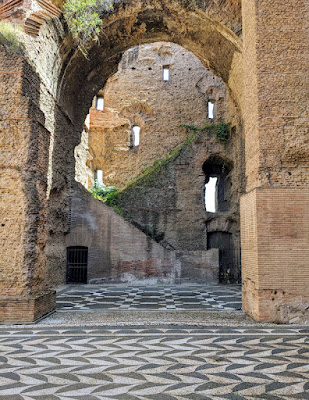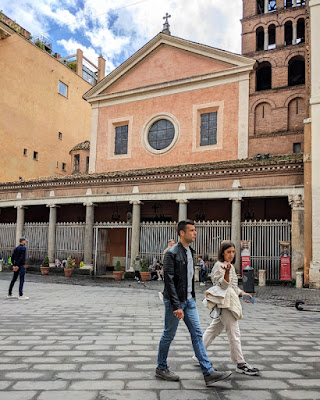John and I got to the Baths on a regular Rome city bus.
If you want to "get small in Rome" this is a great place to do it. The 3rd century AD complex is enormous..jpg)
The Farnese Hercules is now in the Archeological Museum in Naples. The site's curators have put a life-sized photograph where the statue once stood.
The curators have also put out fragments of the gorgeous mosaics that once adorned the floors of the libraries, gymnasiums, saunas and pools..
The Baths could once accommodate 1600 Romans at a time and would have seen 6000-8000 visitors a day.
The sheer height of the remaining walls is breathtaking
and the remaining mosaic floors are beautiful.
The ruins are also famous for inspiring modern sites like the original Pennsylvania Station in New York City and Chicago's Union Station.
The Baths could once accommodate 1600 Romans at a time and would have seen 6000-8000 visitors a day.
The sheer height of the remaining walls is breathtaking
and the remaining mosaic floors are beautiful.
The ruins are also famous for inspiring modern sites like the original Pennsylvania Station in New York City and Chicago's Union Station.
Buried beneath the baths,
Only a small part of the original Baths remains, yet John and I were stunned by it's size and magnitude.
This worker was cleaning the floor of a swimming pool as we passed.
so the glory of the original mosaic patterns is not concealed by debris.
We couldn't help but feel in touch with the ancient, individual bathers
who would have passed time playing on this game board carved into the marble poolside.
excavators have uncovered the remains of an opulent Roman home from around 134-138 AD.
The dining room has some beautiful frescoes.Only a small part of the original Baths remains, yet John and I were stunned by it's size and magnitude.
This worker was cleaning the floor of a swimming pool as we passed.
so the glory of the original mosaic patterns is not concealed by debris.
We couldn't help but feel in touch with the ancient, individual bathers
who would have passed time playing on this game board carved into the marble poolside.
Nothing builds an appetite like exploring the glories of yesteryear. The app on John's phone directed us to the bus stop that would take us back downtown and to lunch.














































